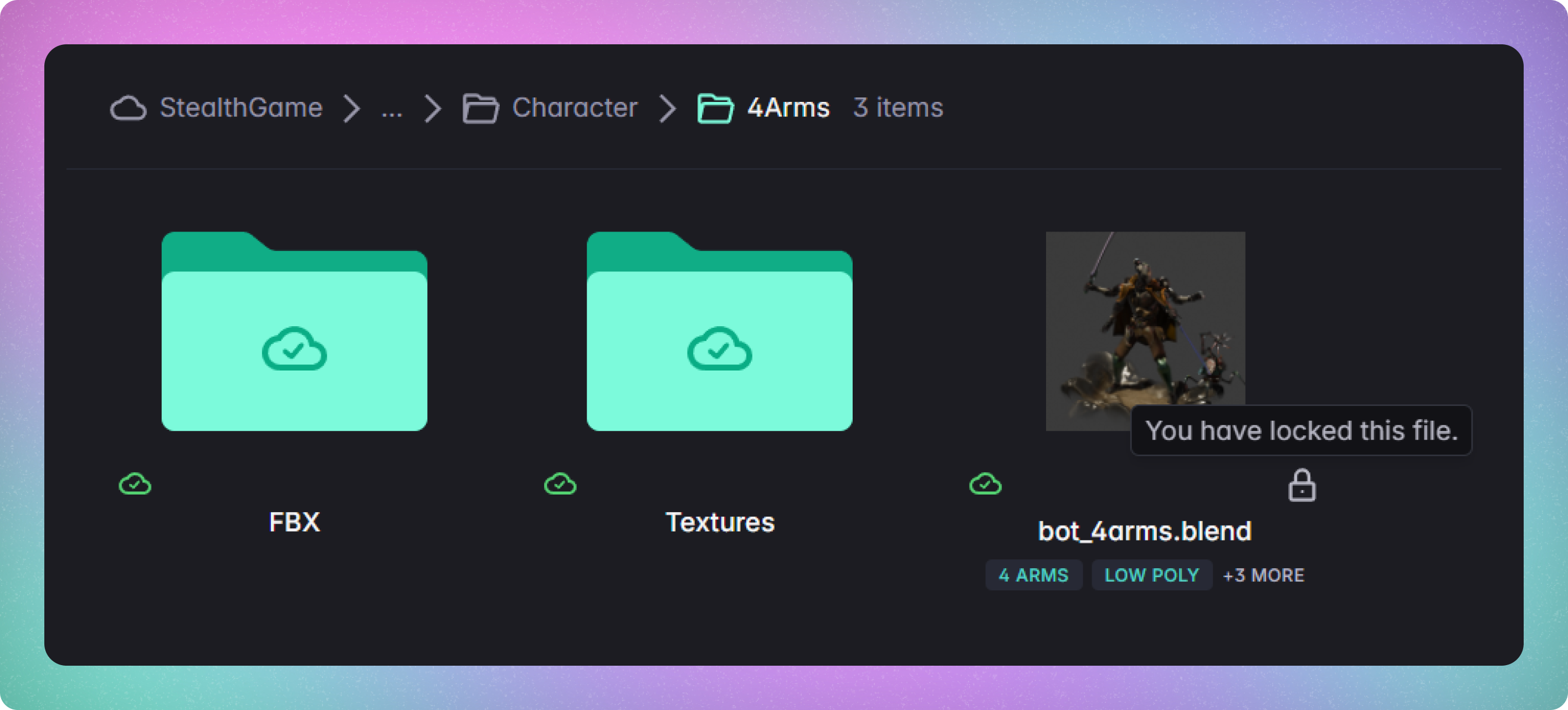Create a File
Simply move your desired files into the local directory location. You may also create or save files in this folder to automatically add them to the directory. Created files will not go to the cloud automatically. A version must be committed, then pushed to upload to a cloud workspace.Locking Files
For teams that have a content pipeline with sequential handoffs, this locking system will give you a status for when a file is being worked on by someone else.
Lock files to prevent other users from pushing changes to a file until you unlock it.
Only the user that locked the file (and account admins) can unlock it.
Create a Folder
You have several methods to create a new folder:- From grid or list view: Click the
Create folder herebutton in the toolbar - In your local directory:
- For Windows: Use Explorer and choose
Create New Folder. - For Mac: Use Finder and select
New Folder.
- For Windows: Use Explorer and choose
Moving Files and Folders
To reorganize your files and folders:- To the Breadcrumb Bar: Click and hold the desired file or folder. Drag and release it onto the breadcrumb bar at the top.
- Into a Folder in View: Click and hold the file or folder you wish to move. Drag and release it into the desired folder.
Cut and Paste
Cut:
Select file(s).
Click the Cut button on the top right bar or right-click and choose Cut.
Paste:
Navigate to desired location.
Right-click in or on the folder.
Select Paste.
Large
cut/paste actions may take some time.Renaming
To rename a file, select it, open itsInfo tab, and click the Edit button next to the file name.
You can also rename a file from your Windows Explorer or Mac Finder and Mudstack will track this change as long as it is running.
File Subscription
To receive file notifications on your dashboard, click theSubscribe button. Click it again to unsubscribe.
Automatic subscriptions occur when you:
- Comment, review, or take action on a file.
- Upload a new version of a file.
- Create a new file.
Sync States

- Local - File only exists locally, and can be pushed to the cloud
- Cloud - File only exists in the cloud workspace, and can be pulled (downloaded) from the cloud
- Synced - File exists in the cloud workspace, is mapped to your local directory and in sync
- Local Changes - A previously synced file that now has local changes, and can be pushed to the cloud workspace
- Conflict - A previously synced file has local changes but is out of sync with the cloud because another user has pushed their changes to the cloud. Your changes aren’t based off of the latest cloud version.
Delete Files and Folders
Deleting of cloud content is a 2 step process in Mudstack, similar to that on your OS. The first step sends the selection to the Trash. To permanently delete files from the Trash, you can empty the Trash.Moving Files to Trash
To send files/folders to the Trash:- Right-click and select
Send to Trash, or - Use the
Trashicon in the top actions bar when you have one or more items selected.
Emptying Trash
Once files are in the Trash, if you want to permanently delete them, you can do so from within the Trash. To get to the Trash, click on the Filters icon in Search and selectGo To Trash.
Here you can either selectively empty the trash of files or restore them to their original locations, or permanently delete them by emptying the trash.
Permanent delete actions will also need to be pushed to the cloud for the changes to affect everyone else.
Deleting via Your OS
If you delete files or folders from a local directory that’s mapped to a cloud workspace using your Windows Explorer or Mac Finder, Mudstack will assume by default that this was an error, and show the file or folder as missing. If this was an error, you can right click andRestore the missing file/folder. This will place the file back in its original location but it will not appear on your disk unless you re-enable syncing for the file.
If this was not an error, you can select Remove. Files removed this way will be sent to the trash.
Multi Select
To select multiple files, holdShift or Control and click on each file that you want to select.